
Here you will learn about number patterns, including how to find and extend rules for sequences, input/output tables and shape patterns.
Students will first learn about number patterns as part of operations and algebraic thinking in 4th and 5th grade. They continue to build on this knowledge in middle school and high school.
Number patterns are groups of numbers that follow rules. They can use input/output tables to create sequences.
Two types of sequences are arithmetic and geometric.
Each sequence has a starting number, a rule and terms (the numbers that make up the sequence).

Rule: Subtract 6 each time.
There are also patterns, between the terms of two or more arithmetic sequences.
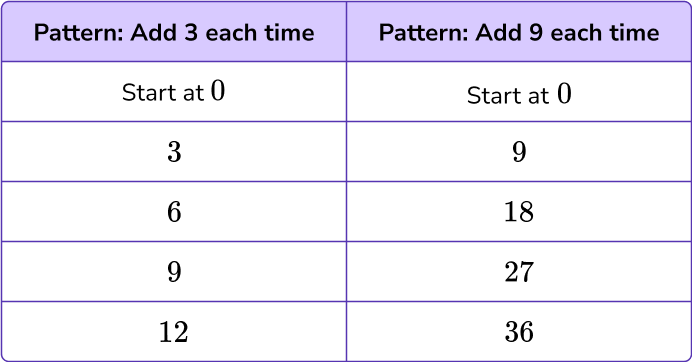
Both sequences start at 0. If you multiply the left column by 3, you get the terms in the right column.
This is because using the rule +9 is three times more than the rule +3.
Step-by-step guide: Arithmetic sequence

Rule: Multiply the previous term by 5.

Rule: Divide the previous term by 3.
Step-by-step guide: Sequences
This page will highlight rules that involve whole numbers only.
![[FREE] Number Patterns Worksheet (Grade 4 to 5)](https://thirdspacelearning.com/wp-content/uploads/2023/07/Number-patterns-check-for-understanding-quiz-listing-image-.png)
![[FREE] Number Patterns Worksheet (Grade 4 to 5)](https://thirdspacelearning.com/wp-content/uploads/2023/07/Number-patterns-check-for-understanding-quiz-listing-image-.png)
Use this quiz to assess your grade 4 to 5 students’ understanding of number patterns. 10+ questions with answers on 4th and 5th grade number pattern topics to identify areas of strength and support!
![[FREE] Number Patterns Worksheet (Grade 4 to 5)](https://thirdspacelearning.com/wp-content/uploads/2023/07/Number-patterns-check-for-understanding-quiz-listing-image-.png)
![[FREE] Number Patterns Worksheet (Grade 4 to 5)](https://thirdspacelearning.com/wp-content/uploads/2023/07/Number-patterns-check-for-understanding-quiz-listing-image-.png)
Use this quiz to assess your grade 4 to 5 students’ understanding of number patterns. 10+ questions with answers on 4th and 5th grade number pattern topics to identify areas of strength and support!
What is the rule for the table below?
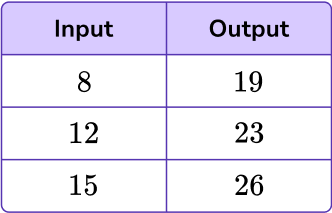
To find the rule, look for the relationship between the input and the corresponding output.
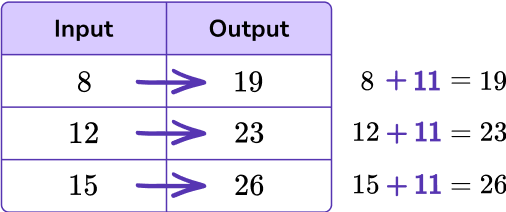
Notice, 11 is being added to each input to get the output, so the rule is ‘add 11. ’
Step-by-step guide: Input/output tables
As students learn to work with number patterns, they can learn more about generalizing patterns by working with shape patterns.
A repeating pattern has a core that repeats over and over again.

The core of the pattern above is:

The core can be used to extend the pattern.
The next shape in the pattern would be:
because the last part of the core shown is:
.
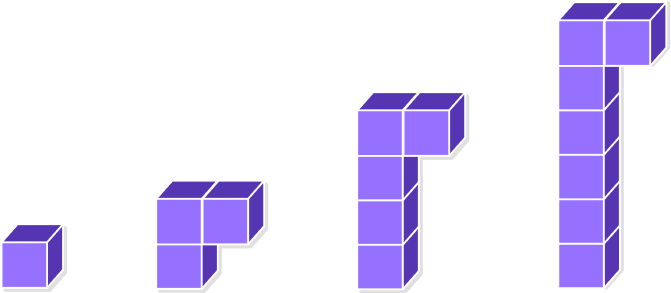
Step-by-step guide: Shape patterns
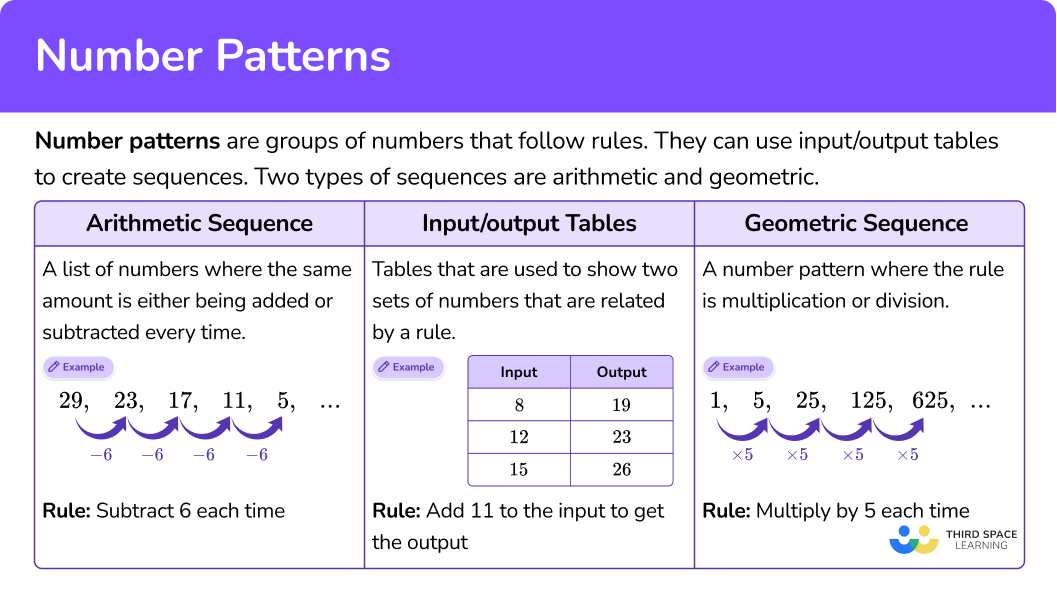
How does this relate to 4th grade math and 5th grade math?
There are a lot of ways to use number patterns. For more specific step-by-step guides, check out the pages linked in the “What are number patterns?” section above or read through the examples below.
What are the next three terms in the pattern?

Rule: Multiply the previous term by 2.
2 Use the rule to extend the pattern.
Multiply the last term by 2 to extend the pattern to the next three terms.

3 State and explain any patterns within the terms.
Except for the first term, all the terms are even.
The first term is odd, but multiplying it by 2 (even), makes the next term even.
From then on it is always an even term times 2 \rightarrow \text < even >\times \text < even >=\text < even >.
Compare the following sequences:
0, 2, 4, 6, 8… \, and \, 0, 12, 24, 36, 48…
Identify the rule of each sequence.

Find a pattern between the related terms of each sequence.
Look at the related terms for each sequence. What do you notice?
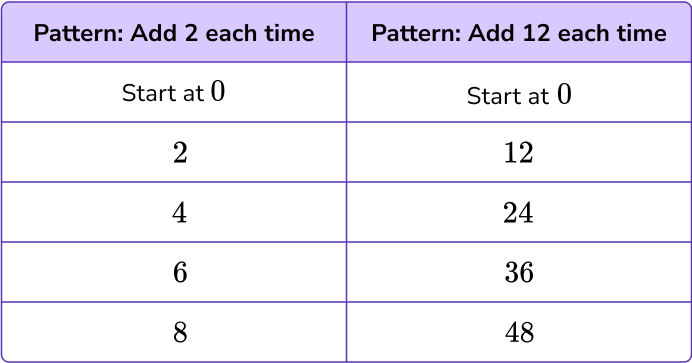
Both sequences start at 0. If you multiply the left column by 6, you get the terms in the right column.
Use the pattern to write a comparison statement.
The terms in the second sequence are 6 times the terms in the first sequence.
This is because using the rule +12 is six times more than using the rule +2.
What is the rule for the table?
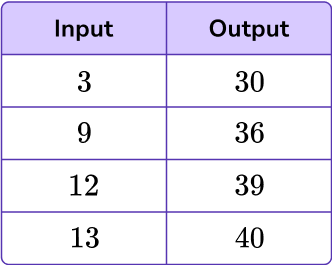
Look at the relationship between the input and the corresponding output.
Looking from each input to output, see if you notice an obvious relationship. If not, use subtraction to find the difference between each input and the corresponding output.
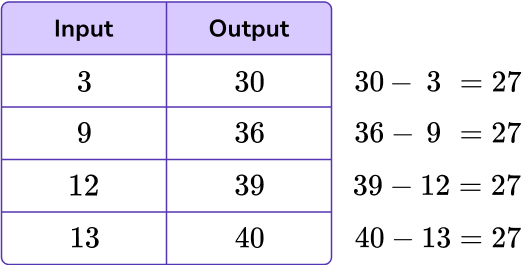
Decide if the rule is add/subtract or multiply/divide.
Each output is 27 more than the input, so the rule is addition.
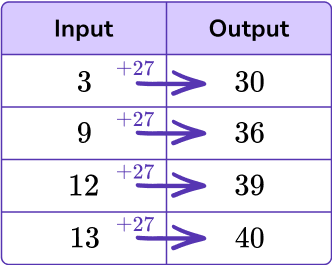
Write the rule.
Rule: Add 27 to the input.
Find the missing value in the table.
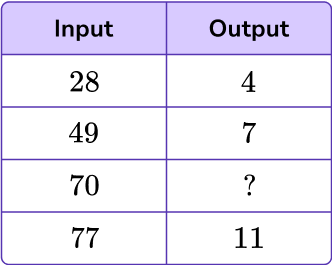
Look at the relationship between the input and the corresponding output.
Looking from each input to output, see if you notice an obvious relationship. If not, use subtraction to find the difference between each input and the corresponding output.
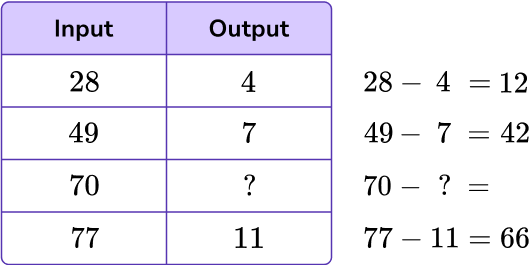
Decide if the rule is add/subtract or multiply/divide.
From each input to output, the difference is not the same, so the rule is not addition or subtraction.
Try to find a relationship that involves multiplying or dividing. Since the relationship from input to output is decreasing, try division.
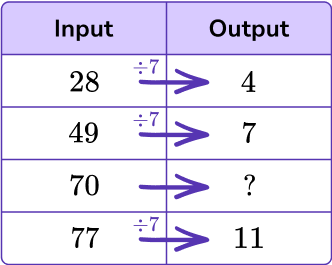
Write the rule.
Rule: Divide the input by 7.
*Note, the rule ‘Multiply the input by \, \cfrac \, ’ is also correct.
Use the rule to find the missing value(s).
The missing value in the table is 10.
Create a rule for the pattern and find the next shape.
![]()
Identify the core – the part of the pattern that repeats.
This is a repeating pattern with cubes that go purple, purple, orange, purple, red, purple.

Notice that purple is repeated multiple times within the core. Always look at all the shapes given to confirm the pattern core.

Use the core to find and justify the next part in the pattern.
The next shape is:
because the last part of the core shown is:
![]()
Create a rule for the pattern and find the next shape.

Identify what is changing and what is staying the same.
Create a rule based on Step 1.
Start with 1 triangle. Add 1 triangle to the top and 1 triangle to the left side each time.
Use the rule to find and justify the next part in the pattern.
The next part in the pattern is:
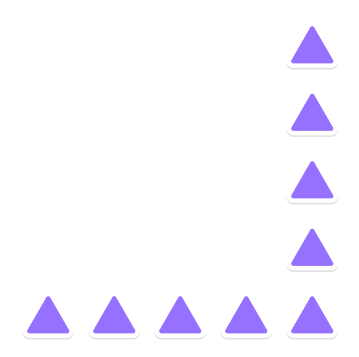
because 1 triangle is added to the top and 1 triangle is added to the side each time.
For example,
What is the rule for the pattern 10, 20, 30, 40, 50?

To find the next term, you need to add 10, not multiply.
Even though the terms are multiples of 10, for this to be the rule, there would need to be corresponding inputs and outputs, such as…
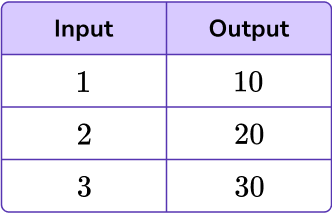
For example,
What is the rule for the pattern 3, 6, 12, 24, 28?
